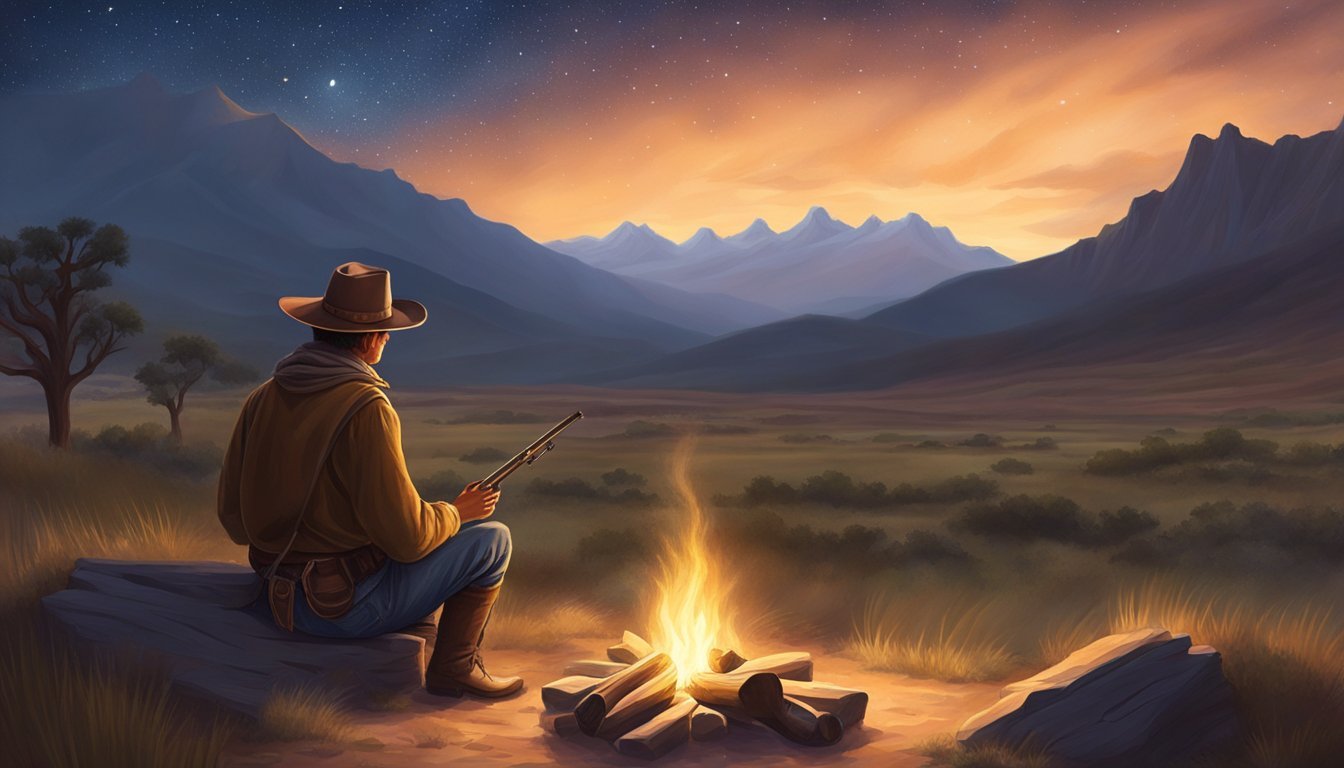Cowboy Spirituality and the Connection to Nature
Exploring the Symbiotic Relationship
Cowboy spirituality is an aspect of American culture that intricately intertwines the individual's identity with the vastness of nature. It extends beyond the familiar image of cowboys herding cattle across open plains; it is a lifestyle deeply rooted in respect for nature's power and beauty. This form of spirituality emphasizes a close, almost symbiotic relationship with the natural elements, where cowboys often experience a sense of soulful connection and spiritual fulfillment through their daily tasks that mirror the forces of nature.
American traditions and the identities of various cultures, including those of indigenous peoples, have long been shaped by their interaction with the land. For Native Americans, this connection is a core tenet of their spirituality, where nature is not only a physical space but also a spiritual one filled with meaning and guidance. Similarly, the cowboy's spiritual experience is heavily influenced by their constant engagement with the natural world, sometimes embodying the untamed spirit of the places they hold sacred.
In the broader context of spirituality in art and traditions, the cowboy's close companionship with nature often inspires expressions of the American spirit throughout various cultural artifacts, reflecting a shared reverence for the land across different American identities. Whether through the quiet reflection of the cowboy on the range or the deep-rooted traditions of Native American tribes, the spiritual rapport with the environment is a defining characteristic that continues to shape the soul of American culture.
Historical Context of Cowboy Spirituality
Cowboy spirituality has deep historical roots and a complex origin story that intertwines with indigenous cultures and the broader fabric of American cultural history.
Indigenous Influence on Cowboy Beliefs
Historical interactions between cowboys and Native American tribes significantly influenced the spiritual outlook of the former. Cowboys found themselves deeply intertwined with the natural environment, a cornerstone of Native American spirituality. Respect for land and animals was paramount in indigenous traditions, and as cowboys spent considerable time in these same natural settings, they adopted similar beliefs. The natural world wasn't just a resource but a part of their spiritual existence, mirroring the deep connection that Native Americans had with the environment.
Roots of Cowboy Spirituality in American Culture
Cowboy spirituality is also a product of the romanticized American West. It reflects the values and narratives that defined the nation during the expansion to new frontiers. These cultural roots are traceable to the post-Civil War era, where the iconography of the lone cowboy and the open range proliferated. This folklore was a melding of factual histories and embellished tales, with cowboy figures often embodying freedom, self-reliance, and a storied connection to the divine through nature. This amalgamation of real and imagined experiences served to cement the cowboy as a symbol of American spiritual and cultural identity.
The Spiritual Significance of Nature
The deep connection between Cowboynatureyb Spirituality and the natural world centers around healing, respect for living entities, and the integration of this reverence into daily practices and ceremonies.
Nature as a Source of Healing
Cowboys are known for their rugged lifestyle and profound respect for the natural world, often turning to the great outdoors for physical and emotional healing. The wide-open landscapes provide a sanctuary for reflection and rejuvenation, as the solitude and beauty of nature promote a sense of inner peace and recovery from life's adversities.
Animals and Plants in Spiritual Practices
In Cowboy Spirituality, animals—especially horses—are not just companions or tools but are considered spiritual beings that offer guidance and strength. Plants, ranging from healing herbs to hardy shrubs that survive the harsh environment, are also incorporated into their spiritual practice, respected for their resilience and life-sustaining properties.
Natural Environment as Sacred
The natural elements—earth, water, air, and fire—are seen as sacred components of the natural environment. Formations like mountains and forests are not merely landscapes but are revered as places of power, spirituality, and connection. These areas are often considered sanctuaries where one can commune with the divine, appreciating the intricate balance and harmony inherent in nature.
Nature-Based Spirituality in Rituals and Ceremonies
Rituals and ceremonies in Cowboy Spirituality frequently involve elements of the natural world to emphasize the cycle of life and the connections between all living things. Elements such as flowers or tree branches may be used symbolically to mark life transitions, while the phases of the moon and changes in seasons can dictate the timing of these spiritual practices, aligning them with the rhythms of the natural world.
Practical Aspects of Spirituality
In the realm of cowboy spirituality, daily practices and the use of natural elements play a pivotal role in nurturing the connection between the cowboy, his environment, and his inner spirit. These practices are grounded in tradition and are central to maintaining both physical and spiritual balance.
Spiritual Rituals in Cowboy Life
Cowboys integrate spirituality into their lives through rituals that infuse their daily tasks with a deeper sense of purpose. Rituals like early morning meditation under the vast open skies assist in grounding their energy before beginning the day's work. They often encompass elements of nature, using the rising sun or the expansive horizon as focal points for prayers and reflective thought, reinforcing their spiritual growth and balance.
Use of Herbs and Natural Elements for Healing
In cowboy spirituality, the body's healing is often addressed through the use of herbs and natural elements that the land provides. Common practices might include:
Creating poultices from herbs to address wounds or inflammations.
Utilizing meat in traditional diets to sustain the body's strength and vitality.
Prayers said over an afflicted area, often accompanied by the laying on of hands.
Spiritual Tools: Crystals, Flowers, and Totems
Cowboys may carry or utilize certain natural items as spiritual tools to enhance their connection to nature and spirit. Examples include:
Crystals, to channel energy and promote healing or clarity.
Flowers, carried or worn as a reminder of nature's fleeting beauty and life's cycles.
Animal totems, respected as kindred spirits or guides in one's journey. These may be adopted after particular ceremonies or encounters in the wild, symbolizing specific traits or lessons.
Environmental Ethics and Sustainability
In the realm of Cowboy Spirituality, the ethos of environmental ethics and sustainability harmonize with a deep respect for nature and a call to action for its preservation. This section explores the intrinsic value of the natural world and the spiritual practices underpinning the environmentalist movement within this unique cultural perspective.
Respecting and Conserving the Natural World
With an inherent respect for the environment, individuals who embody Cowboy Spirituality acknowledge the sacred gift of the natural world. They hold strong beliefs in conservation efforts, recognizing the importance of maintaining a balance in the ecosystems they inhabit. Sustainable practices are not just strategic choices but moral imperatives that reflect a profound respect for all living beings. They see humans as stewards of the Earth, where sustainability is a guiding principle ensuring that natural resources are used in ways that regenerate rather than deplete them.
Key aspects of this environmental ethic include:
Protection of wildlife habitats
Advocacy for policies that mitigate climate change
Environmentalism and Spiritual Practice
The practice of environmentalism within Cowboy Spirituality extends beyond mere activism; it is an expression of the interconnectedness of life. Their practices often involve rituals and traditions that honor the Earth, recognizing every mountain, river, and plain as part of a larger sacred whole. This reverence is lived through their daily actions and choices, cultivating a lifestyle that exemplifies their deep spiritual connection with nature.
Important elements of these spiritual practices include:
Mindful ranching and farming methods
Eco-friendly riding and herding techniques
Community gatherings to promote environmental awareness
Through these approaches, Cowboy Spirituality offers a compelling narrative that combines the pragmatic aspects of environmental sustainability with the profound respect and spirituality of those who feel intimately tied to the land.
Spirituality in Daily Life
Incorporating spirituality into daily life involves deliberate practices that connect the mind, soul, and actions to a deeper sense of purpose and balance. Individuals draw from their respect for nature and mindfulness to guide their decisions and cultivate peace within themselves.
Meditation and Mindfulness Practices
Meditation is a cornerstone practice for individuals seeking spiritual awakening. By focusing on the breath and stilling the mind, they achieve a state of clarity and peace. Mindfulness exercises involve present-moment awareness, which allows individuals to approach their day with kindness and intentionality, fostering a balanced mental state.
The Role of Intuition and Reflection in Decision Making
Decision-making is informed by intuition, a potent form of internal guidance that reflects one's spiritual energy and core values. Reflection is equally essential, as it helps to evaluate past actions and outcomes, offering a chance for growth and deeper understanding. This process imbues one's daily life with a sense of reverence and thoughtful respect.
Fostering a Connection with the Natural World
A connection with nature is integral to many spiritual practices, as it represents the interplay of life and spiritual energy. Respect for natural surroundings encourages mindfulness and a reciprocal relationship where actions echo with a reverence for the living world. This symbiosis nurtures the soul, promoting a peaceful coexistence with the environment.
Spiritual Growth and Personal Development
In the context of Cowboy Spirituality, personal development often parallels the natural progression of the journey—both literal and metaphoric—embodied in the cowboy's experience with the vastness of nature.
Spiritual Experiences on the Trail
On the trail, cowboys encounter an expanse of nature that provides ample space for spiritual awakening. The open landscapes are not just a backdrop but a participant in the spiritual journey. As they spend days or weeks under the open sky, cowboys report heightened consciousness and clarity in their thoughts, drawing lessons from the rhythm of nature.
Lessons of Presence: The call of a hawk or the sound of a river can teach mindfulness, a key component of spiritual growth.
Harmony with the Environment: Riding through various terrains inspires a deep sense of harmony with nature, akin to moving within a sacred circle that fosters a sense of identity rooted in the land.
Lessons Learned from the Wild
The wild, with its unforgiving beauty and harsh challenges, imparts invaluable lessons to the cowboy's spirit that can lead to healing and a richer quality of life.
Resilience: Nature's uncertainty teaches cowboys resilience, an important lesson for personal development.
Inner Strength: Overcoming obstacles on the trail parallels the journey of spiritual and personal strengthening.
Both resilience and inner strength contribute to an individual's spiritual growth, providing insight beyond the physical experience. Through their intimate connection with nature, cowboys often reveal a sense of unity in life's journey and the quest for a more profound sense of self.
The Future of Cowboy Spirituality
Cowboy spirituality has traditionally emphasized respect for the land and a deep connection with nature. As society progresses, this form of spirituality faces the challenge of remaining relevant and providing continuity for the values it represents.
Adapting Traditional Practices to Modern Times
Adapting cowboy spirituality to modern times involves integrating age-old traditions with contemporary environmental ethics. Conservation becomes a key tenet, as it aligns with the cowboy's inherent respect for nature and the need to sustain natural resources. The lessons of frugality, stewardship, and living in harmony with the land from cowboy spirituality can inform modern practices in sustainable agriculture and land management. Incorporating these practices into current societies enhances quality of life by fostering a sense of responsibility towards the environment.
Preserving Spirituality for Future Generations
To ensure that cowboy spirituality endures, it is crucial to educate future generations about the cultural significance and ethical frameworks inherent in this tradition. Engaging in storytelling, mentorship, and community rituals can pass down the core values and beliefs that this spirituality harbors. Methods such as interactive workshops, youth rodeo events, and wilderness camps can help embed the importance of this connection with nature in younger people. By doing so, they carry forward a legacy that helps maintain diverse cultures and enriches overall societal well-being.
Cultural Expressions of Spirituality
Cultural expressions of spirituality, particularly within the context of American culture, often manifest through various art forms and rituals. These not only reflect religious beliefs and perceived connections to the divine but also solidify cultural identity.
Art and Literature as Reflections of Spirituality
Art and literature serve as vital mediums for expressing the spiritual beliefs and traditions of a culture. In the portrayal of Cowboy Spirituality, art often depicts expansive landscapes and scenes from ranch life, symbolizing a connection to nature. It's a visual embrace of wide-open spaces where the forces of nature command respect yet offer a sense of freedom and spiritual solace. Literature, encompassing genres like autobiographies, fiction, and poetry, further explores these themes. It captures the rugged individualism and the intricate relationship cowboys share with nature, which lies at the heart of their spiritual experience.
Music, Poetry, and Dance in Rituals
Music, poetry, and dance are integral components of spiritual rituals and celebrations, engraining spirituality into the very fabric of cultural traditions. Specifically, in Native American ceremonies, music and dance transcend mere performance—they facilitate a deep communion with nature and ancestral spirits. The drumbeat resonates as the heart of the Earth, while the rhythmic movement in dance signifies the natural ebb and flow of life forces. The oral tradition of poetry, often shared around campfires or during gatherings, tells of personal struggles and triumphs, reflecting the cowboy’s respect and awe for the natural world as an extension of their spiritual identity.
Conclusion
The essence of Cowboy Spirituality finds its roots in a profound respect for the forces of nature. At its core, it emphasizes a harmonious balance between humans and the natural world. This cultural tradition is marked by rituals and practices that aim to foster spiritual growth and peace within the individual and the community.
Throughout history, cowboys have learned valuable lessons from their environment, understanding the need for conservation and the interconnectedness of life. They normally perceive nature not just as a backdrop for their livelihood but as a central component of their spirituality and culture.
Traditions have been passed down, reinforcing the importance of a symbiotic relationship with the environment. Such traditions are important as they inculcate a sense of consciousness about the environment's significance to their way of life.
Cowboy Spirituality thus stands as a testament to a culture's adaptation to its surroundings, where respect and rituals are instrumental in maintaining balance and harmony. It offers insights into how spirituality can be weaved into daily practices, promoting interconnectedness with the natural world and advocating for the preservation of the environment for future generations.








